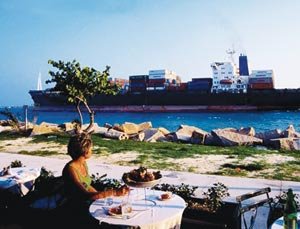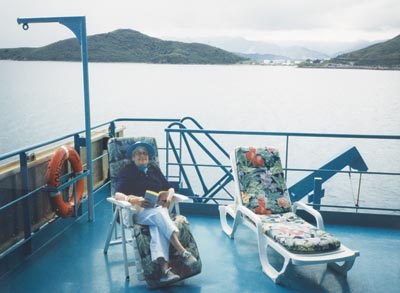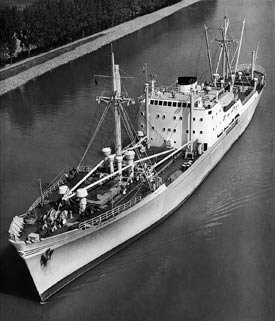 The Zenica of Croatia’s Jadroplov (Adriatic Steamship) offered voyages to the Great Lakes since 1959, the year when the new Seaway was opened. I began my seafaring career on this ship as a cadet in 1961. ~ Capt. Ranko Zunic |
Westport, CT - On the eve of The Freighter Travel Club’s 50th anniversary we are reprinting some of the more interesting articles from the December 1958 charter issue of the Freighter Travel News. This will be followed by a full set of today’s Q&A Freighter Cruise Guidelines.
1958 - 2008 Then and Now Established and presided by Reg Clark for 20 years, followed by Lee Pledger for an additional 25, the club's purpose was to facilitate an exchange of information among its North American members. In these modern, Internet days, the club is run by Capt. Ranko Zunic, President and Ian Turner, Editor and has the broader mandate of being an international club that can also provide its members with the ability to easily book freighter voyages. |
Then, in 1958, the Club's newsletter content looked as follows: Hamburg-American Line, North German Lloyd |
| This jointly operated service offers one of the best travel bargains we know of. Operating from Vancouver, BC to Hamburg and Bremen there are many ports of call enroute so that the full trip takes approximately 42 days at a cost of only $500 or $12 per day. At these rates you cannot afford to stay home. Embarkation ports are Vancouver, Seattle, Portland, San Francisco and Los Angeles, and you may book passage to Antwerp, Amsterdam, Rotterdam or first German port. From California the fare is $460.00. Both fares quoted are for accommodations in two berth cabins with private shower and toilet. Deck space is ample and public rooms include a smoking room and bar. Excellent German food is served. Sailings about every three weeks. |
Foreign languages
|
| With no language except English you can travel the world without too much difficulty, however you will encounter many people with whom you would like to establish some communication and who do not speak English. For this purpose we recommend that you take with you four small pocket dictionaries - French, German, Italian and Spanish. These cost about $1.25 each and are available at any stationary store. Your ship’s officers and stewards will undoubtedly speak English but there will probably be passengers who do not. With the aid of these dictionaries you can spend many interesting hours writing and deciphering notes to each other. |
Shall I take my car?
|
| A member of the Club is planning a five month tour of Europe and inquires about taking his car on the freighter. Of course he can take his car with him, however most people prefer to rent a car in Europe or buy one there on a guaranteed re-purchase plan. There are a number of reasons why we think it better not to take your car, not the least of which is the expense. From the Pacific Coast to Europe and return it will cost from $800 to $1,000. In addition gasoline costs in Europe are high and the smaller European cars will save many, many dollars in fuel costs alone. Further, with the exception of a few magnificent highways like the Autobahn in Germany, European roads are narrow and winding and American cars are simply too long and too wide for comfortable driving. |
Seasickness
|
| One of our neighbors says he gets seasick in a rowboat so he is sure he wouldn’t enjoy a sea voyage. He couldn’t be more wrong. If you are subject to motion sickness you should take with you one of the new remedies and we feel sure you will have no serious discomfort. While we have seen some touches of seasickness recently it has been years since we have known anyone to be sick enough to miss a meal. Most of the time, and especially when the ship is loaded, the decks of a freighter are as steady as your living room floor. |
Age limits
|
| A man of 71 asks our opinion of the advisability of his booking passage to England by freighter. If you are in good health you should certainly take your trip. If you have a history of any serious disease, or if you think you might need medical attention, don’t take a freighter, take a passenger ship. There are some lines that will not take passengers over 70 and almost all require a medical certification of good health if you are over 65. This certification should be a letter from your own doctor on his letterhead. First aid is always available on shipboard and it is also well to remember that life on shipboard is healthier than on land. You will get more rest, there are no tensions and certainly there are fewer germs. |
Now
|
| 1) What do passenger freighters today consist of? Two basic groups of working ships set aside cabins for passengers: freighters and mail/supply ships. Freighters, including containerships and general cargo ships, are one of the lifelines of the world economy, but of the oceangoing ships in the world, only about 1% carry both passengers and cargo. It's a special niche serving those travelers with the time and temperament to sail long itineraries - anywhere from a few weeks to several months - and who don't mind doing without the amenities of a modern cruise ship. Most of these ships are French and some German, all with international officers and crew onboard, offering accommodations for 2 to 12 passengers on roundtrip voyages, as well as longer one way voyages (between the continents only). |
| Containerships carry shipping containers stacked like so many building blocks, and account for the bulk of oceangoing trade today. The average port time is one day. |
 |
 |
General cargo ships often transport large or unwieldy goods. Port time varies from one day to several days. |
| Supply and mail ships run supply routes to isolated coastal communities and distant islands. Port time can vary from half a day to two days. |
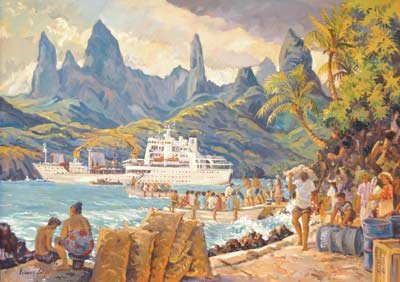 |
| Q. & A. Freighter Cruise Guide Includes passenger comments |
| 7) How do passengers spend time onboard? “It sounded a bit intimidating, but it was amazingly civilised. Informality and good fellowship was one of the perks, as was the freedom, and time, to unwind. It's not like when you're at home and have a lot of time. You're not mulling over your past. It's all about the voyage and the future and what you're going to do in next port”.  Picnicking on the forecastle “As a group we eat together, enjoy happy hours with one another, occasionally play games or watch movies and sometimes share with one another our time on the deck. We also share our experiences with one another when it is needed, but it is never taken for granted that we function as a group. We discuss what we want from the port visits and how we will do them. Often we share a cab into town and then we separate. Sometimes we share the visit or tour, but there is never the expectation that we are responsible for one another ... I have my laptop computer with me and it includes an encyclopedia, a world atlas, and a world book, so I am very much enjoying the opportunity to study up on the next place where we will be landing. I also have my digital camera with me which allows me to create instant slide shows of the ship and ports visited. I spend time on the bridge and on deck enjoying the scenery and watching our progress ... The sea also mesmerizes me. For me there is something very natural and whole about being at sea. I am somehow in tune with the motion of the ship, even when we are in rolling waters. I sleep very deeply, almost as if I am in a cradle. There is an energy surrounding us in this great outdoors, and it is healing. I feel peaceful, healthy, safe, and joyful. Life is good”. |
| “Our fellow passenger, an artist named Emmelene, has invited me to sit for an oil painting. This will be a gift from her to us and will certainly be another first in my young life. I am very excited about this and cannot imagine what the results will be like. She is definitely an accomplished painter, but we are not sufficiently cultured to fully appreciate all the merits of her work. My first sitting is scheduled for 2 PM today. Stay tuned for further developments ... |  |
  |
8) What on board facilities and services can I expect? ACCOMMODATIONS Passenger cabins are located on upper decks and have the same facilities as officers’ cabins, including private baths and air conditioning. They are more spacious than cabins on the average cruise ship. Some provide amenities such as a mini refrigerator, TV/DVD and stereo sets, and in house/ship telephone. Front- and aft-facing cabins, may have their views obstructed by the containers stowed on deck. In general passengers and officers share the dining room, lounges with TV and small video and book libraries, as well as the exercise room and sauna, swimming pool and similar facilities found on most freighters. Deck space can be limited but there is always room for sunbathing and deck chairs are provided. |
“Our cabin had two rooms. The main room contained a pullout sofa, coffee table, desk, two armchairs, refrigerator, glass cupboard, bookshelf, and some storage space. The bedroom had a bed we thought too small for two, so I slept on the sofa. There was a hanging closet and plenty of shelf space in the bedroom. Two windows in the main cabin looked aft, and the one in the bedroom opened on the port side. The beds were made up European-style with a sheet and duvet. The bathroom was tiled, with a shower that had a pull-down seat. There was an adequate medicine cabinet. The steward cleaned the cabin once a week, when fresh bed linen and towels were provided”. Officers and passengers lounge FOOD Mealtimes offer an invaluable opportunity to speak with the captain and officers and listen to their maritime stories and anecdotes in an informal and relaxed atmosphere. The English spoken, as well as the food served, is colored by their nationality, which is one of the attractions of traveling by freighter. The meals, prepared fresh and served three times a day, are included in the cruise price. The pantry is usually open to anyone fancying a light snack. On freighters one cannot expect food to satisfy any special dietary needs, but most chefs will prepare something else when the menu of the day is not to someone’s liking. |
| “Meal times were at 7:30 A.M., 11:30 A.M. and 5:30 P.M., and coffee was served at 10:00 A.M. and 3:00 P.M. The meals are more then ample and nourishing as they are prepared for hard-working sailors. For breakfast, eggs are always available, as is some kind of breakfast meat, several kinds of bread, fruit, juice, cheese and cereal. |  |
| The noon meal is the main meal of the day, and usually includes soup, meat, a starch dish, vegetables, salad and fruit. Wine may or may not be included. The evening meal is normally a ragout of some sort, often over rice, with platters of cold cuts, crudités and cheese. Serendipity played an important part in making our dining experience more enjoyable. When we first boarded, meals were adequate but completely uninspired and boring. In Hong Kong we picked up a new chef and what he could do with the same ingredients was a revelation! His garlic and broccoli soup was scrumptious, and the German officers said his konigsberger klops reminded them of home. Passengers and officers shared the dining room, but sat at separate tables”. SERVICE Cabin service is available on a daily or weekly basis, depending on the ship. Linen is usually changed weekly, but will be done more frequently if requested. Meals are served in the dining room only at set times and seatings may be prearranged. The dining room is usually smoke free, while the TV/Bar lounge is not. Basic toiletries and popular beverages and cigarettes may be obtained at duty free prices from a small onboard shop. “The ship has a limited amount of items for sale including toilet soap and washing powder for the laundry and, best of all, liquid refreshments - all at duty-free prices!” Self-service bar accounts can be settled once a week or once a month, with cash in US Dollars or Euro. Self-service laundry facilities are available. Mail needs to be either stamped or paid for, and delivered to a designated officer/purser. “An important thing to keep in mind is that this is a working ship. The officers and crew were always very friendly and polite to us, but they were hired to run the ship, not to entertain passengers or act as tour guides”. “The crew at all levels are gentlemen. In passing, they greet you in some manner, a smile, a wave, or a ‘Morning’. Still, they are professionals with a job to do that does not include entertaining or teaching passengers. This is not to say that they do not engage in conversation but it tends to be on their terms.” 
9) Who are the officers and which language is spoken onboard? English is the lingua franca of all freighters. Officers are offten European, and use their mother tongue among themselves, while crewmembers are usually Filipino, and they speak Tagalog. But when speaking to each other, or to the passengers, they all speak English. Some are fluent, others are not, but they all can answer any questions you may have. 10) What currency is used onboard? It is usually necessary to pay cash using USD for onboard expenses. Personal and traveller’s cheques are not accepted and neither are credit cards. For use ashore, take your credit card, traveller's cheques and a supply of the local currency or US Dollars with you, preferably in small denominations as vessels do not provide exchange facilities. 11) Who should I tip? Tipping is at the passenger's discretion and is limited to the cabin and dining room stewards, often one and the same person, who shares it with the chef. A good guideline is to allow for USD 5.00 - 10.00 a day per person traveling. 12) Are there elevators onboard? Not in many cases, and even when there are, the fact is not broadly advertised. Passengers who must rely on an elevator and who are not fully mobile cannot be accepted on board freighters. “We took a cabin close to the dining room, two decks apart, which meant that we had to climb four flights of stairs for every meal. At first it was daunting, but after a few days it became routine, and the improvement in the shape of my thighs by the end of the trip was worth it all! On an average day I climbed up and down between the bridge and dinning room thirty flights of stairs.” 13) Do freighters have telephone, e-mail and Internet connections? Yes, but these being satellite connections make the fees expensive, as high as $5 per minute. And while the Internet is not available, email (without attachments) works from the Captain's office, free of charge. Of course, there are various options for phone and Internet rental. 14) What is the electricity? Electricity is 220V/50 cycles. A two-prong round adapter and converter are needed for North American appliances. 15) Do freighters have stabilizers? Freighters run deep in the water which slows their motion in rough seas, thus serving them better than any stabilizer. Still, even in normal weather conditions, there is always a roll, a gentle one which conveys the feelings of strength and progress. 16) What clothing should I bring and what is the dress code? |
| The weather can change during any voyage. Take warm practical clothing to wear on deck and good footwear is vital for walks onboard and ashore. Otherwise, dress smart but casual. The following passenger quote provides firsthand advice about what to wear on long voyages in the tropical areas: | 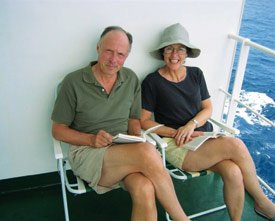 |
 |
Personal belongings and family-size cars are normally transported in 20- or 40-foot closed containers, while mobile homes, due to their size, are often shipped on flat racks or in open-top containers. Transatlantic freight rates for smaller cars start at about $1,500 and motorcycles $500. |
| Here you can access the Freight Forwarding Services Directory. and Export Shipping (Full service ocean freight transportation) 21) Can I bring my pet with me? Unfortunately pets are not allowed onboard. You may wish to use a service such as the following: Pet Movers 22) Is there an age limit? The lower/upper age limits are 14/80 on German ships and 16/77 on French ships (CMA CGM). Exceptions are made on some coastal traders, such as mail and supply ships, where there is a larger group of passengers and a doctor is onboard. 23) What are the visa, medical and insurance requirements? Passports must be valid at least six months beyond the anticipated return date, and foreign visa must be obtained in advance. Vaccination against yellow fever is currently required to visit Mexico and for transit through the Panama and Suez Canals. Currently freighter travel is not available due Covid, and when freighters resume passenger service, a vaccine against it will likely be required on all routes. Regardless of age, all passengers must ensure that they are fully fit to travel and have no serious medical condition. A medical questionnaire must be completed at the time of reservation, duly signed by both your physician and yourself confirming that you are able to travel on a freighter where there is not a doctor on board. And if reservation is made well in advance, the report must be reconfirmed a couple of weeks before departure. International Health and Accident Insurance is mandatory, while Trip Cancellation and Interruption Insurance is not required but is highly recommended to protect your investment against cancellation fees.Please check our web page for some options: Before You Sail. All required documents must be provided within two to three weeks before departure. 24) What services are available in port? While the Captain, officers and port agents may be able to offer some advice about shore visits, one cannot count on this. It's best to prepare yourself in advance and be well-informed about your ports of call and what you want to see. “When we arrived at a port there was no tour bus carrying thirty passengers, or a lady holding her umbrella in the air to show you the sights or guide you to souvenir shops. From the moment we walked down the gangplank, we were on our own. So again, it's a question of whether you like to be led or you like to explore on your own”. |
| “Passengers on freighters have to be self-reliant souls who can keep themselves entertained ... What I really like about traveling on freighters is the fact that there isn’t the pressure to participate in all kinds of organized activities or to take sightseeing tours ashore. |
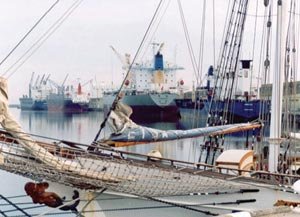 |
| If we want to visit the local attractions, we have to make arrangements ourselves. But that’s the way we like it. On a freighter we feel as if we’re sailing on our own private yacht.” |
|
25) How long do the ships stay in port ...? The average port time is one day, longer for general cargo ships, less for mail ships and smaller containerships. Variations in published shedules often happen due to weather conditions, port congestion, cargo delivery, etc. 26) ... and how far from the town do they dock? Vessels dock at terminals which are often situated outside the center of a town or city, so passengers usually have to take a taxi in. Photo below shows Papeete, Tahiti with freighters at their berths in the background. 
27) How do I know when the ship will arrive and where to board the vessel? Port agent contact information is included with your ticket, which is delivered via email a few weeks before departure. Although ships are late sometimes for a day or two, but also, less likely, can arrive early, for this reason and to have some latitude in the case of your own traveling difficulties, plan to travel to or near the embarkation port a day or two ahead of time. When port agent gets in touch with the ship captain, he will instruct you where the port or terminal gate is and when to be there. Transportation within the terminal (gate to ship) is usually allowed only to authorized vehicles, which may charge for the service (cash on the spot), especially in the US ports. 28) When and how do I make my reservation? Freighter voyages can be booked anytime, from several weeks to a year or more ahead. Travelers who wish to take a particular ship, cabin and time of the year, should make reservations well in advance, or in other words - as soon as you know what you want. To help us make your trip planning and reservation procedures a pleasant experience, please familiarize yourself with this type of travel by reviewing the information on the ship, voyage, General Info. and documents required. Then please apply through our office by giving us as wide a period for your departure as you can, e.g. earliest November 10 - latest December 20, preferably around beginning of December. In consultation with the steamship line/s, we'll offer you the best option/s available. A deposit for 25% of the fare is required to secure the reservation. The balance of the fare is payable 7-10 weeks before departure. Please remember: knowing and respecting the fact that freighter schedules can vary will help put your mind at ease and enable you to better enjoy your voyage and preparations. Ports of embarkation and disembarkation, as well as the vessel and itinerary, may change for a variety of reasons including cargo requirements, holidays, weather conditions, port congestion or other factors beyond the carrier’s control. This may affect your pre- and post-freighter voyage travel arrangements. The steamship line, or its agents, are unable to make those arrangements for you. 29) Comments made by the following authors contributed in this Q. & A. Guide: Bill MacRobbie, Carl I. Swanson, Vivienne Knapp and Bob Hartley. Mr. Hartley’s were taken from his book. 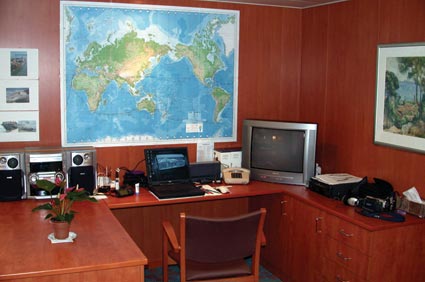
At the end of Mr. Hartley's book, we found the following few lines of advice: “· If you are taking a trip of any length buy a map and hang it on the wall. Looking at the overall route was helpful and prompted many discussions with crew and fellow passengers. Bring double-sided tape for hanging your map as well as for a million other uses. · When I was writing, I left my cabin door open. Many of the tidbits of information in this book came through that open door. · I had little success with a short wave radio and frankly, after a few days at sea I lost interest in ‘worldly’ affairs. · Bring your digital camera. Better still, also bring a small printer. Photos of activities onboard are much appreciated. · If possible, have the ship’s stamp put in your passport. At some ports they gave us a shore pass. Where they didn’t, it was helpful when returning from town to have proof that I was a passenger on the freighter. · When returning from shore leave, bring back a candy bar for the crew member greeting you at the gangplank.” 30) Recommended reading: A delightful wonderful story offering you much to learn about the ship, ports, oceans, and the world while leisurely navigating with Mr. Hartley. We have been pleased to provide you above a few lines from the 160-page book, and you can also read a few longer excerpts in this page. The book, Around the World by Freighter, by Bob Hartley, is available at Amazon for $18.50. |
| For additional information and reservations, please contact us through the Initial Request page. |
|
|
| Thanks to the support received from our customers, as well as from the steamship lines and media, including the following comments, today's Maris is one of the leading independent freighter cruise specialists: |
|
|
|
|
||
|
|
||||
|
|
|
|
||||||
|
|
||||||||
|
|
|
|
||||||
|
|
||||||||
|
|
|
|
||||||
|
|
||||||||
|
|
|
|
||||||
|
|
||||||||
|
|
|
|
||||||
|
|
||||||||
|
|
|
|
||||||
|
|
||||||||
|
|
|
|
||||||
|
|
||||||||
|
|
|
|
||||||
|
|
||||||||
|
Become a member of Maris Freighter Travel Club Int'l - or give a gift membership Take advantage of the knowledgeable advice that comes from our vast experience, starting by reviewing the recommended pages.Find the freighter and voyage that's right for you and, for each booking, you will receive a discount of up to $800, depending on the steamship line and voyage. |
|
Due to Covid, PASSENGER SERVICE ON FREIGHTERS IS SUSPENDED INDEFINITELY, except on the ARANUI and Bella Desgagnés You'll also receive our online newsletter called Seaworthy News, featuring passenger firsthand stories and news, issued periodically as it happens. It's a well-illustrated e-mail publication often being the only one available anywhere for many of these voyages. |
The same low price (in USD) is valid internationally. By placing your order, you agree with our Terms |
|||||
